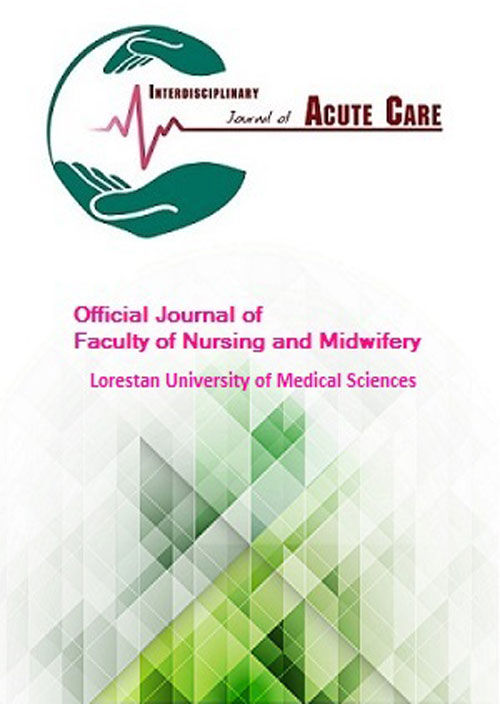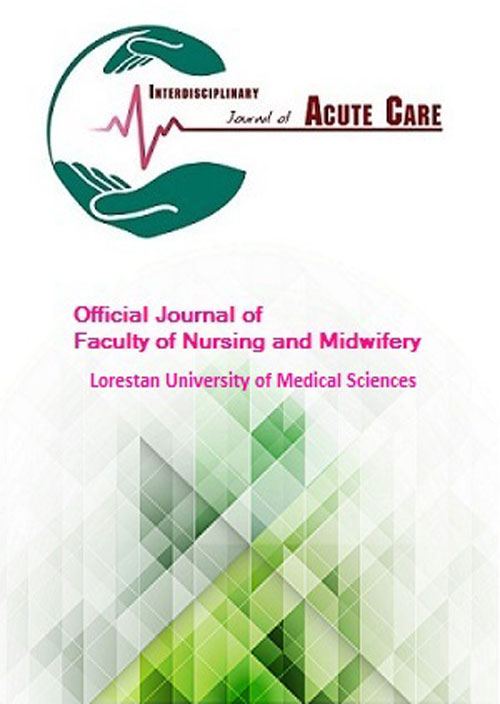فهرست مطالب

Interdisciplinary journal of acute care
Volume:1 Issue: 2, Summer and Autumn 2020
- تاریخ انتشار: 1400/03/26
- تعداد عناوین: 5
-
Pages 34-42
Nowadays, patients’ privacy as an important part of patient’s rights, which is related to his dignity, is regarded as the basis of treatment and care; and its significance as an ethical medical principle is on the increase. Therefore, the current research was conducted to investigate the preservation of patients’ privacy. This research is a cross-sectional descriptive study, conducted on 141 patients (with non-convenience sampling) admitted in the emergency department of Shahid Rahimi Hospital in Khoramabad. Data were collected using a three-part questionnaire investigating patients’ privacy. The results of this study revealed that the highest preserved cases in different dimensions of physical, information, and psychological - social privacy were: sitting on the patient’s bed with his permission), seeing parts of the body of other patients and respecting the values and beliefs of the patient by the medical staff. The most satisfaction case of patients was related to the refusal of the treatment staff from an unnecessary touch of the body and the least satisfaction case of patients was with hearing the conversation of other patients with the doctor or nurse unconsciously. Although the privacy of over half of the patients in terms of physical, information, and psychosocial dimensions was at acceptable level, yet, its observation is at very low level in terms of staff’s treatment ;thus, the managers, physicians, and nurses should pay more attention to this critical need.
Keywords: Patient privacy, Emergency Department, Patient Satisfaction -
Pages 43-50
cutting edge educational methods are necessary. This study aimed to evaluate the impact of telenursing follow-up on dietary adherence in patients on hemodialysis. In this quasi-experimental study, 44 hemodialysis patients were selected using census sampling from the patients admitted to Imam Jafar Sadeqh hospital in Aligudarz in 2013. All the participants received a three-day training about their self-care. Then participants were randomly divided into two groups of case and control group. Telephone intervention was conducted in experiment group for 12 weeks. Data collection instruments were questionnaires and physiological measurement instruments to which were used before and after the study. In the case group, there were significant differences between the mean dietary adherence before and after the intervention in all dimensions included low-fat diet (t=15.96, df=21, means difference=4.55, p <0.05), protein containing diet (t = -4.16, df=21, mean difference= 3.86, p <0.05) and controlled water and electrolytes diet (t = -12.26, df =21, mean difference=13.32, p <0.05). These findings confirmed the positive effect of telenursing intervention on the improvement of adherence to diet in patients on hemodialysis.
Keywords: Telenursing, Hemodialysis, Diet adherence, Treatment Adherence -
The Effect of Music Therapy on Chest Tube Removal Pain in Patients Undergoing Heart Bypasses SurgeryPages 51-57Chest Tube Removal (CTR) is deemed as a painful procedure that may not respond well to palliative therapies and there is no selected and recommended procedure and guideline to manage CTR pain. This study is intended to examine effect of music therapy on reducing pain during and after CTR. This study is a randomized clinical trial with a control group and which has been conducted on 90 hospitalized patients under heart bypass surgery inintensive care units where they had at least a pleural chest tube. Patients were divided randomly into two groups so that there were 45 participants in each group. Music was played for the patient by headphone in Group-A from 15 minutes before until 15 minutes after CTR and only usual interventions were executed for chest tube removal in the Group-B. The pain severity was measured in two groups before, during and 15 minutes after chest tube removal by visual analogue scale. ANOVA with repeated measures test were employed for data analysis. There was no statistically significant difference in the baseline pain score among the study groups (P=0.53). There was nostatistical significant difference between scores of pain severity during chest tube removal among music group (4.93±1.06) and control group (4.73±1.08) (P=0.36). There was no statistical significant difference between scores of pain severity 15 minutes after chest tube removal between two groups (P=0.31). Music therapyas non-pharmacological intervention dose not effect on the pain relief caused by CTR.Keywords: Chest tube, Pain, Music Therapy, Visual Analog Scale
-
Pages 58-65
Insufficient health literacy and incomplete information related to disease management can affect treatment regimen adherence. This study was performed to determine the relationship between health literacy and treatment regimen adherence in CVD patients hospitalized in the educational hospitals of Khorramabad city in 2017. In this descriptive cross-sectional study, 161 CVD patients hospitalized in two educational hospitals of Khorramabad city were chosen through available non-probabilistic sampling method to participate in the study. Data collection instruments included sociodemographic information form, health literacy questionnaire, and treatment regimen adherence questionnaire. Descriptive statistics, Pearson and Spearman correlation coefficients were used for data analysis. The health literacy of 75.2% of cases was borderline/average. Also, 68.9% of them adhered to the treatment regimen to an average level. There was a significant and positive relationship between the total score of health literacy and the total score of treatment regimen adherence (p <0.000, r=0.74). In this study, those with higher health literacy also showed greater adherence to the treatment regimen. Thus, promoting health literacy can be an effective tool to enhance the treatment regimen adherence behavior.
Keywords: Cardiovascular disease, Health literacy, treatment regimen adherence -
Pages 66-73Empowering patients after coronary artery bypass graft surgery has a major role in promoting their health behaviors and improving self-efficacy is one a way to increase this skill. This study aims to compare the effectiveness of center-based rehabilitation and telephone follow-up on self-efficacy of CABG patients. In this randomized controlled trial, 77 patients undergoing CABG referred to Shahid Madani Medical Educational Center of Khorramabad were selected by convenience sampling. Then, they were randomly divided into two groups: telephone follow-up (N=38) and control (N=39). The intervention group received cardiac rehabilitation for 4 weeks and the control group did not receive any intervention. Trail questionnaires were completed by the patients before (at discharge) and after the study. The mean score of pre-study was not significantly different between the two groups (P = 0.960). But the findings after the study showed that self-efficacy was significantly different in the clinical practice of patients in the follow-up group compared to the control group (P = 0.001). Based on the findings on the effectiveness of telephone follow-up in increasing the self-efficacy of patients undergoing CABG, it is recommended to use this method as a low-cost but effective method.Keywords: Rehabilitation, self-efficacy, CABG, follow-up, telephone follow-up


